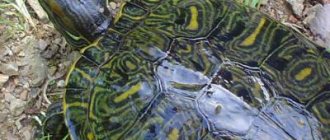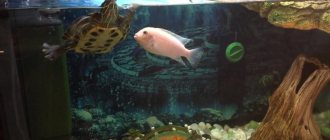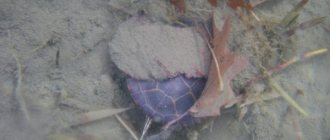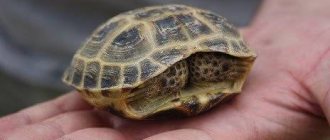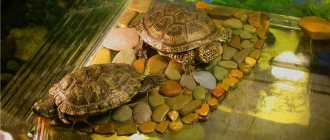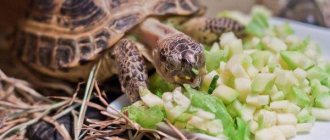Turtle lovers often argue whether it is necessary to hibernate their pets? There is no clear answer in the literature on keeping turtles.
Some authors believe that turtles should not be hibernated, especially for novice owners. They motivate their point of view by the fact that it is quite difficult for an inexperienced tortoisekeeper to properly organize the conditions for hibernation. They advise feeding the turtle well and heating it properly, and then it will safely survive the cold season without hibernation. Other authors, for the benefit of turtles, recommend artificially inducing animals into a state of hibernation, but be sure to properly prepare the animal and control the temperature. In addition, it is believed that hibernation is one of the factors that stimulate the reproduction of turtles. Therefore, if next year you expect to get offspring from your animals, it is better to hibernate them.
How do turtles sleep?
Aquatic turtles (red-eared, marsh) can sleep both on land and under water. Sleep can also catch them during a walk, when the owner releases the animal from the aquarium. Therefore, you need to do this only for a few hours and periodically monitor your pet so that it does not get lost or get stuck in hard-to-reach places.
Most often, domestic red-eared turtles sleep on land. They climb onto the island, close their eyes, calm down and fall asleep. Some animals retract their head and paws into their shell, while others do not. They leave their head extended and simply close their eyes. This happens because they get used to a calm environment, the absence of predators and competitors.
However, the red-eared turtle can also sleep in water. A sufficient amount of air accumulates in her lungs, the supply of which lasts for several hours. The animal sleeps in the water, completely submerged there, or stands on its hind legs on the bottom of the aquarium, and rests its front legs on an island or other object. The pet can spend several hours in a row in this position.
When and how long do they sleep?
The answer to this question is ambiguous, since each animal develops its own habits over time. The duration of sleep and the characteristics of biorhythms depend on a number of factors:
- Gender
: Males have been found to sleep longer than females. Males can be distinguished by their more powerful paws and long tail. - Age
: young individuals are very active, they can swim around the aquarium all day, play, run around the room if the owners let them out. As a result, such turtles fall asleep for several hours, just like a person. They get very tired and can sleep all night. An old turtle often falls asleep on the go, it is slow and behaves calmly, so it requires less time to sleep. - Health status
: if the pet is cheerful and behaves as usual, nothing threatens its health. But sometimes the animal can become slow, falling into a kind of hibernation for 5-7 days in a row or more. Inexperienced owners may even think that the reptile has died, although in fact it is simply resting to recuperate. - Individual characteristics
: it is not the duration of sleep that depends on them, but biorhythms, i.e. time of falling asleep and waking up. There is no general law here: some turtles like to sleep during the day, after which they make noise all night. Others, on the contrary, fall asleep at night because during the day they are disturbed by light, noise from people, household appliances, etc.
If your turtle sleeps too long or too little
In this case, you just need to observe the behavior of the animal. If the pet eats well, swims actively, communicates with other neighbors in the aquarium, i.e. behaves as usual, her health is safe. Typically, such periods of instability end after a few weeks, after which red-eared turtles spend the night in their usual rhythm.
If your reptile sleeps very little and is too active, it should be taken to the veterinarian. He will be able to clarify the reason for this behavior and prescribe sedatives and other medications. If turtles sleep a lot, literally for several days in a row, but wake up, feed, swim and fall asleep again, this is quite normal. If a sleeping turtle is not active at all, this may indicate the beginning of the development of the disease.
The only exceptions are those cases when the animal has gone into hibernation. This usually happens during the autumn-winter season, provided that the owner specially prepares the pet. To do this, reduce the temperature in the aquarium for several days in a row, significantly reduce portions or do not feed the turtle at all, etc.
Is the turtle sleeping or dead?
Sometimes your pet will look like she has died while sleeping because she:
- does not move his head;
- does not move his paws;
- doesn't wake up;
- does not eat;
- doesn't float.
To accurately answer this question, you need to bring a metal object to your eye. This could be a coin, jewelry, or any other item with non-sharp edges. If after contact the eyes sharply go into the orbit, then there is a reaction and the turtle is alive. If there is no reaction, death can be declared.
The red-eared turtle sleeps, like many other animals, several hours a day. However, the duration of sleep and the time of its onset depend on the individual. Therefore, it is important for owners to study the habits of their pet in order to notice the symptoms of a possible disease in time, and also to understand that the turtle has simply gone into hibernation.
Source
Turtle hibernation in winter
In their natural environment, when the air temperature drops, turtles need to hibernate. By making some observations of a reptile in the wild, you can accurately determine the duration of its sleep. Based on this information, you can understand how much red-eared turtles sleep at home, however, when creating comfortable conditions for the reptile to live in, the turtle does not need hibernation in captivity.
In nature, a turtle can sleep for five months, while its breathing is practically not carried out. The processes that occur in the reptile’s body slow down, and the life cycle is maintained with the help of fat, which the reptile accumulated during the active period of the year. However, when kept at home, it is highly not recommended to create conditions under which the turtle will hibernate.
Remember! A pet turtle does not need to hibernate every year and will feel better staying awake all year.
If for some reason it is necessary to hibernate a domestic reptile, this should be done gradually and following certain rules. The process of preparing a pet for hibernation involves certain preparations, namely:
- you need to not give the turtle food for a month,
- plant it in moss of a certain humidity,
- create a gradual decrease in temperature and a decrease in daylight hours.
In most cases, a turtle's sleep at home lasts no more than three months.
Adviсe
- The turtle will not play like a cat or dog.
- Protect your pet from drafts, feed it a variety of food, and treat it on time.
- Think carefully about the purchase, because the pet lives quite a long time, and if released into the wild, it will die in the natural conditions of central Russia.
Turtle is a great choice for people who don't like noise. A leisurely turtle relaxes and clears the mind of hustle and bustle, and taking care of it brings true pleasure.
Previous InhabitantsWhat to feed omnivorous and herbivorous land turtles at home? Next InhabitantsTricks for keeping a Chinese newt
Sleep process in turtles
Every representative of the turtle world sleeps in its natural habitat. Reptile sleep has different types and durations. It is likely that the turtle is more active at night, but during the day, it can sleep peacefully. There are also individuals that can sleep at night, but at the same time, they also rest during the day. The pet can sleep both on land and in water. However, it is possible to answer the question of where red-eared turtles sleep. In most cases, these reptiles fall asleep on land.
Diseases
Reptiles rarely get sick even under harsh conditions. The following diseases are distinguished:
- Skin. Not considered dangerous to creatures. The main reason is the unusual habitat. The problem is expressed by the appearance of ulcers, abscesses, and deformation of the skin. Main skin diseases:
- Peeling usually signals another, more serious problem. Appears in infectious diseases, an excess of vitamins A and B. Treatment is prescribed after accurately determining the cause of the disease.
- Abscess: the main symptom is tissue swelling. The animal is in severe pain. If measures are not taken, tissues begin to die. Treatment is possible only surgically.
- Dermatomycosis is caused by a fungus that appears on aquariums due to significant accumulations of uneaten food. Infection occurs under certain conditions: crowded conditions (when the red-eared slider shares housing with someone else), dirty water with an incorrect acidity level. The symptom manifests itself in the form of a gray - white coating, deformation of the armor or detachment of plates from the cornea.
- Diseases of the armor. The following diseases are possible:
- Rickets – due to calcium deficiency;
- Osteomyelitis is the appearance of rough pink spots. The entire top layer dies off, yellowish areas form on the remaining surface.
- Fracture – due to careless handling of a red-eared turtle.
- Necrosis of various types - when infectious agents penetrate deep into cracks in the armor. First, the scutes are separated, then the bones underneath are affected. The response to manifestations must be immediate. When treated, the red-eared turtle stays on land.
- Eye diseases. Usually caused by a violation of the content rules. Dirty water, infection with streptococcus or staphylococcus bacteria, or complications from other ailments.
- Respiratory tract diseases. Pneumonia is the most common problem. Appears when the usual habitat changes, drafts or hypothermia. Breathing is hoarse, mucus forms in the mouth. Should be treated with antibiotics.
- Others, which include worms, gastritis, constipation, etc.
Most diseases of red-eared turtles occur under incorrect conditions of detention and transportation. The reptile needs to be carefully examined and listened to the sounds it makes to determine a change in condition.
Factors affecting red-eared slider sleep
The first factor affecting a reptile's sleep is its activity level. The duration of sleep depends on how active the pet is. If the turtle doesn't move much, it won't sleep very long. But with a very active lifestyle and great mobility, the reptile will succumb to sleep for a longer time.
Another factor is the gender of the reptile. It is impossible to distinguish between individuals at a small age, and no one can do this. The sex of a turtle can be determined at a later age. It is necessary to compare the length of the tail of individuals, since the male will have it longer, as well as the length of the claws, which will also exceed the females in importance.
Sometimes, during the occurrence of certain types of diseases, the turtle’s life cycle is disrupted, and in turn can cause very long sleep, or, conversely, its complete absence.
It is impossible to say exactly how long turtles sleep when kept at home. Since a reptile’s sleep directly depends on the created living conditions, as well as on the character of the individual itself.
Did you like the article? Take it to your wall and support the project!
Do you want to have a hypoallergenic, quiet, interesting pet that does not require walking and at the same time decorate the interior of your home? Then the decorative red-eared turtle will be an excellent option. How to care for it and what is required for this will be discussed below.
Treatment
Treatment of mycoses in land reptiles should also be handled by a veterinarian. Self-medication is fraught with deterioration of the pet’s condition or the occurrence of relapses. The following clinical picture is typical for dermatomycosis of Central Asian turtles:
Treatment of mycoses in Central Asian turtles is based on the destruction of the pathogenic fungus and restoration of the integrity of the surface cover and defenses of the reptile's body.
For antifungal therapy of reptiles, the following therapeutic measures are prescribed:
- Isolating a sick pet.
- Disinfection of the terrarium.
- Installation of sources of daytime and ultraviolet irradiation.
- Bathing in baths with Betadine.
- Treatment of the shell and skin with a solution of hydrogen peroxide and anti-inflammatory ointments: Lamisil, Nizoral, Triderm, Akriderm.
- Tetravit or Eleovit injections.
- Antibiotic therapy - Baytril injections.
- Use of hemostatic agents: Dicinone, ascorbic acid.
The effectiveness of the treatment can be judged by the absence of the appearance of new lesions, as well as the healing of the skin and shell. Depending on the severity of the pathology, therapy for dermatomycosis in land turtles can last from 3 weeks to 3 months.
Setting up an aquaterrarium
For one ward you will need a 100-liter aquarium; a couple of different sexes will need a capacity of 150 liters or more. Next, we create the interior of the turtle’s home, taking into account the fact that land should occupy approximately 25% of the area of water. At the same time, let’s not forget our interests – the beauty of the aquaterrarium. If you wish, you can purchase an artificial shore at a pet store, but then you won’t get a real corner of wildlife. But you want not only to keep the red-eared turtle, but also to enjoy the whole composition.
We will be guided by the last condition:
- Place a large stone with a flat surface at the end of the aquarium. When calculating its size, take into account the distance from the top edge of the future aquaterrarium - it should not exceed 40 centimeters.
- If the land slope is not gentle enough, you need to make a bridge to it from the water. Frequent, stable steps made of smaller stones or suitable driftwood without jagged edges will do.
- Next, we fill the soil not only at the bottom. Be sure to fill the space between the walls with stone and under the bridge. If this is not done, even though it is aquatic, the reptile may get stuck there and drown. The size of the soil also matters - red-eared turtles can swallow small pebbles and die.
- Living bottom plants will be quickly eaten. Therefore, it is better to choose emergent species with a root system located in ceramic pots or other reliable decorations at the bottom. For example, dwarf papyrus, water hyacinth and similar vegetation.
We will return to the small but important details of the interior later. Now it’s time to pour water into the almost finished aquaterrarium. Let's start with its parameters - temperature 22-28ºС, soft like peat, with neutral acidity. It is important to take into account the water level - it should be such that a turtle turned over on its back can find support on the bottom or decorations and independently return to its original position. Now regarding the required equipment:
- A good external filter for the red-eared turtle is very important because it feeds and defecates directly in the water.
- To heat the shore, you need a regular 40W lamp located directly above it. Stronger light bulbs can only be installed at a distance from land above fifty centimeters - otherwise burns cannot be avoided. The optimal temperature of a dry surface should not exceed 35ºС.
- Ultraviolet lamp for reptiles. It makes more sense to purchase it in a specialized store. It is better not to experiment with UV lamps intended for humans - the wavelength is completely different and the reptile’s body will not produce the vitamins necessary for the absorption of calcium.
- Thermostat to maintain a constant water temperature. When purchasing it, make sure that you need a model that is suitable for the aquaterrarium.
After the housing for the aquarium red-eared turtle is ready, it is recommended to let it stand without a pet for at least a couple of days. By the way, it needs to be positioned so that it is not exposed to direct sunlight. While the water is settling, there is time to go to pet stores in search of a “new home.”
Selection and transportation
Small, about 2.5 centimeters long, the young turtle looks very impressive. The stripe running from the eyes to the neck is bright red, the shell is rich green on top, and lemon yellow underneath. Moreover, it is all “painted” with black and yellow stripes, which are intertwined into a complex pattern - you want to buy such beauty without hesitation. However, experienced breeders recommend purchasing one-year-old individuals, 5-6 centimeters long, that have “proven” their viability.
For an older red-eared slider, the description will not be so impressive - over the years the colors become less vibrant. By the way, you can determine its age by simply measuring the length of its shell with a regular ruler. With proper care, it gains 2.5-3 centimeters in length per year. The red-eared turtle reaches its maximum size at about 6 years of age. By this time, males reach 17 centimeters, females are 3 centimeters larger. Now let's see what else is important to consider when choosing a ward:
- The shell should be oval, slightly convex on top, without deformation. Its too curved shape indicates rickets.
- Take a closer look at how your potential pet behaves in the water. For example, if a red-eared turtle swims sideways, refuse to buy it - this is a sign of pneumonia, which is too troublesome to treat.
- Carefully inspect the skin, eyes and claws - the latter should not delaminate. The soft surfaces must be healthy, that is, without signs of peeling, cracks or abrasions. The eyes are wide open and shiny.
Another important question when choosing a pet is how to determine the sex of a red-eared slider if you decide to get a pair. You can distinguish a male from a female once they reach 2 years of age. At this age, “boys” begin to form a more concave lower part of the shell, grow long claws on the front legs and develop a genital organ hidden in the thickened base of the tail. The latter in “girls” is noticeably shorter and thinner; in addition, “ladies” are larger and the anus is located closer to the shell.
After the choice is made, another task arises, namely the question of how to transport the red-eared slider so that it does not get too stressed. First of all, consider the time of year and travel distance:
- If the journey takes no more than a day, a cardboard box with holes for ventilation and soft bedding is enough. For example, a simple cotton towel will do.
- In the summer heat, it is better to take a spray bottle of water with you and spray your “passenger” as needed. In winter, long-term transportation is not recommended. Maximum 4-5 hours in an insulated container heated by your body temperature - that is, in your bosom.
- If longer transportation is necessary, it is best to get a small aquarium made of lightweight plastic. However, keep in mind that a water turtle can drown without access to land. Therefore, you need to either put an “island” in a container of water, or regularly pick it up in your hands.
So, the house was prepared as comfortable as possible, healthy pets were selected and brought in - the main part of the work was done. It remains to figure out how to care for the red-eared turtle so that it continues to be healthy. By the way, when choosing this reptile, keep in mind that with proper care it can live for 40 years and become a real member of the family.
Description of the species
Red-eared turtles in nature reach 30 cm in length (based on the shell), but when kept at home they rarely grow to that size. Females are significantly larger than males. The shell of juveniles is bright green, but as the turtle matures it becomes brown or olive in color with patterns of bright yellow stripes.
The head, neck and paws of the animal are decorated with a series of white and black stripes. The species got its name due to the bright red spots near the eyes. These “ears” can also be deep orange or rich yellow. It is thanks to its bright appearance that the red-eared turtle has become one of the most popular exotic pets.
She prefers to lead a sedentary lifestyle, but swims very quickly in the water and is extremely curious. May hiss and snort, expressing his displeasure and anxiety. When defending its life, it can inflict serious wounds with the sharp claws of its hind legs. In the cold season, a phenomenon called suspended animation, or hibernation, occurs for red-eared turtles.
Care, feeding and breeding
How long a red-eared turtle lives at home depends on its owner. Therefore, wishing your pet health and long life, follow the following feeding regimen:
- Young turtles, up to 2 years old, need to be given protein and plant foods daily in appropriate proportions of 3/1.
- For sexually mature four-year-old reptiles, feeding every other day and gradually reducing the amount of protein is sufficient.
- Elderly children over 10 years old can be given food once every 3 days. Moreover, the older you get, the less protein food you eat, gradually reducing it to nothing.
Now let's see what to feed the red-eared turtle in addition to balanced ready-made food:
- Lean meat, seafood and insects;
- Green vegetables such as cabbage, cucumbers or zucchini;
- Wild seasonal greens - plantain, dandelion leaves and nettles.
In addition to proper nutrition, careful care of the red-eared turtle is required, regardless of its age:
- Once a week, clean the bottom with a siphon and change 1/3 of the water.
- If necessary, wash the shell with a soft sponge. However, keep in mind that even a young turtle can bite hard.
- Turn on the UV lamp above the aquaterrarium for at least 3 hours a day.
Speaking of lighting, this begs the question of how the red-eared turtle sleeps and does it need hibernation? At a constant water temperature, it is not necessary for a domestic reptile to go into seasonal suspended animation. The duration of daily sleep on land may be determined by the conditions in which the pet is kept. For example, if the ward is not disturbed during the day, he will sleep well and will rustle about his business at night.
The red-eared slider's behavior may change during the breeding season. Moreover, at home this can happen at any time of the year. If you notice that the male is courting the female and she is intensively digging in the ground, trying to make a nest, help her. To do this, lower the water level to about 12 centimeters so that the female can rest her paws on the bottom and keep her head in the air - otherwise an ardent suitor may drown her during copulation.
Also take care of the nest - place a sufficiently large container with wet sand in the aquaterrarium. Then you can move the clutch to an incubator with a temperature of 26-30ºС and expect offspring after 2-4 months. By the way, you can “program” the sex of the babies - at a low temperature, males will hatch, a high temperature guarantees females, and a medium temperature will ensure a 50/50 ratio of both. In any case, the red-eared turtle, which has high intelligence for a reptile, will “appreciate” the efforts of the owner and over time will become completely tame.
What to feed the red ear?
When living in captivity, the diet of this species of turtle must include shrimp or any other small crustaceans. The red-eared turtle will happily feast on river snails, small pieces of fresh fish or meat, as well as bloodworms and earthworms. Turtles need to get enough calcium, otherwise shell diseases will begin. Poor appetite may indicate illness. Hibernation of red-eared turtles is also preceded by a decrease in interest in food.
It is worth adding plant foods: duckweed, seaweed, lettuce, spinach, cabbage. Due to the active growth of the body, young individuals need twice daily feeding. Turtles over two years old should be fed no more than three times a week. With a monotonous diet, it is worthwhile to provide feeding with special vitamins for turtles.
How to tell if a turtle is sick or hibernating
As a rule, turtles kept in apartments do not need long hibernation. With the onset of seasonal cold, in October-November, the inhabitant of the aquarium may slightly change her behavior. She loses her appetite and sleep duration increases. But she is unlikely to hibernate, since the apartment is quite warm and light, and her own “home” is also additionally illuminated.
On the other hand, the behavior of a turtle, which its owners regard as hibernation, can be a dangerous and sometimes fatal disease. Therefore, if the apartment is warm, and the turtle is sleeping, you should sound the alarm. The first thing you need to do is touch it: if the head and limbs are extended and do not respond to touch, it is likely that the pet has died. When a living turtle gets into warm water, it will definitely begin to move its legs and try to swim. Another sure way to determine if a turtle is alive is to check the corneal reflex. If the eye does not react to the touch of any object, then the turtle has died.
The red-eared turtle is one of the most common pets. We fell in love with the turtle for its unusual bright color and its ease of care. However, many people do not know the rules for keeping a turtle.
or simply ignore the recommendations of veterinarians and pet store sellers. This leads to problems with her health and physical condition. It often happens that after buying a red-eared turtle, the owners bring it home and notice that it is inactive, sleeps most of the time, is lethargic, and refuses to eat. In fact, there are a huge number of reasons for the occurrence of such syndromes, so let's look at the conditions in which the turtle is kept in order to eliminate our own fault.
The red-eared beauty comes from America, it’s not for nothing that its second name is the American turtle
. This pet will be a great friend because... At home and with proper care, turtles are active and very hardy. These pets often have a distinct personality and character, and are very intelligent and quick-witted. If you have two individuals, you can observe the aggressive antics of the red-eared slider - taking food, fighting, rivalry. At home, turtles live quite a long time, up to 40 years. Another pleasant bonus of purchasing such an animal is the absence of allergies to it. The red-eared beauty is known for its striking olive-colored coat, with a red stripe running across its entire body. The size varies, from 3 cm to 30 cm, and it is worth considering that at home, red-eared turtles develop much faster than in nature.
The turtle can also make characteristic sounds - hissing, squeaking or snorting.
What other health problems may owners of red-eared turtles face?
In fact, for all their vitality, reptiles are still prone to many diseases. The following changes in condition should alert the owner:
- The appearance of mucous discharge from the nasal or oral cavity. This symptom signals a viral disease or vitamin A deficiency. In these conditions, the cornea and the epithelial layer located in the reptile’s nose are affected.
- Swelling in the ear area. In red-eared turtles, these areas are marked with red stripes. Most often, swelling occurs due to otitis media. It can be practically invisible, not exceeding a few millimeters in volume, or significant, such tumors are measured in centimeters. Otitis often develops due to hypothermia, much less often due to injury to the turtle.
- Roll while swimming. This can happen for two reasons: the turtle swallowed stones or contracted pneumonia. In the first case, it is worth observing the behavior - if the reptile passes a lot of stones, then everything is in order, and it does not have intestinal blockage or other problems with the gastrointestinal tract due to what it has eaten. Most likely, the owner will have to remove small particles from the tank, leaving only those stones whose size does not allow the inhabitant to “profit” from them. Often such an eating disorder is associated with a lack of minerals in the body; it is worth consulting a veterinarian on this issue. When your pet has pneumonia, other signs of illness also appear: swelling of the eyelids and discharge from the sinuses.
- Swelling of the limbs. This is one of the main symptoms of gout, a joint disease caused by the accumulation of uric acid. The disease develops against the background of serious disturbances in the functioning of the kidneys, dehydration, or abnormally intensive growth of young animals. More often, the disease is detected by chance, less often - changes are detected on x-rays. Sometimes turtles show similar signs not because of gout, but because of arthritis, and then the reptile’s limbs fail. Other signs of gout include bloating of the body, swelling of the eyelids, enlargement of large joints and slight swelling of the area under the jaw. The disease is serious and requires treatment. Moreover, positive results can be achieved only in the initial stages of the pathology. And when changes become obvious, therapy is ineffective.
- Lethargy, apathy. If the behavior of the turtle has changed, it behaves less actively and more often prefers to lie down, it is worth taking a closer look at the condition of the reptile. First of all, you need to observe your pet; perhaps you will be able to identify other signs of the disease. With many diseases, lethargy and weakness are symptoms, so if the pet’s condition worries the owner, it is worth visiting a veterinary clinic with him. If you ignore such signs, you may lose your four-legged friend.
Many diseases are contagious, so a sick aquarium inhabitant should be immediately separated from the rest of the inhabitants. Newcomers should first be kept in quarantine. In many ways, the health of red-eared sliders is related to the conditions of their detention and the quality of food. And these factors depend on the owner - the more he pays attention to his pets and cares about their comfort, the longer they will delight with their presence.
How to care for red-eared turtles
To keep a turtle you will need an aquarium, choose the size yourself, but keep in mind that they grow quickly, in the future they will need a lot of space. It is also worth building an island for access to land. The island must be installed so that part of it is covered with water; it must be secured well so that the turtle does not get hurt; Also, the most important thing is that the island must be heated and warm so that the reptile can bask on it. It is also worth purchasing a heating lamp to maintain the required temperature; you also need a UV lamp, which will help properly absorb calcium in the body so that the turtle does not suffer from rickets or a bent shell.
To keep your turtle healthy, you need to monitor its diet.
. The types of food are very diverse; they can be vegetables, special foods, insects or plants. The main condition is a large amount of calcium in the products, which is necessary for the formation of the shell.
The diet should be age appropriate. Young reptiles are less demanding, while adults need plant food, which should be in abundance.
Water is the main condition for keeping the red-eared turtle. There should be a lot of water and it needs to be changed often, because... pets live in this water, eat, and go to the toilet. Otherwise, reptiles may get sick from microbes that develop in dirty water.
It is necessary to constantly maintain the water temperature at 23 °C and above. At low temperatures, the reptile may go into hibernation, from which it may not emerge, and then die from dehydration.
Everyone noticed that the turtle’s claws and beak grow very quickly, and they also require special care. As the claws grow, they need to be trimmed, otherwise the pet will not be able to move on land. You can do this yourself or by visiting a veterinary clinic.
It would be a good idea to watch the following video
Dangerous! Never trim the growing beak; it provides turtles with the opportunity to eat meat.
Purchase
Before getting a turtle, read the description of care features and purchase everything you need to ensure a comfortable life. Be prepared for additional costs associated with keeping turtles in your home.
After purchasing, take your turtle to the vet. He will determine the age and sex of the animal, and examine it for wounds, injuries, infections, and diseases.
In a new place, the turtle will need an adaptation period to get comfortable. Do not disturb her again, provide proper care and nutrition.
If you acquire a new animal for company living, organize a quarantine zone for the newcomer for three months. Do not place cubs with adults, they will be injured. Only animals that are similar in size and living conditions can be combined in one space.
Expenses
In addition to a terrarium or aquarium with additional equipment, a heating lamp, include in the cost of good quality food, examination or treatment by a veterinarian.


